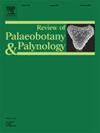New callistophytalean species from the Duckmantian of the Kladno-Rakovník Basin, Czech Republic
IF 1.7
3区 地球科学
Q2 PALEONTOLOGY
引用次数: 0
Abstract
Small-pinnuled last order pinnae of a newly described taxon have previously been found relatively commonly at the Pchery locality, Theodor Coal Mine, in the Kladno-Rakovník Basin. Although foliar fragments of this plant have been known for over a century, the remains have yet to be formally identified because they share features characteristic of the neuropteroids (venation and cordate base of pinnules) and sphenopteroids (small pinnules). This taxon shows some resemblance to the species Pseudomariopteris cordato-ovata and Mariopteris occidentalis, both belonging to Order Callistophytales. However, the remains from the Theodor Mine do not have the lobed pinnules known for Mariopteris occidentalis, nor the prominent basal lobe typical of mature Pseudomariopteris cordato-ovata. Nonetheless, cuticles of all three of these species demonstrate some similarities, including adaxial cuticles showing elongated cells with very small trichome bases, and stomata with polar prolongation. However, differences also exist. The species from the Theodor Mine has small trichomes formed by barrel-shaped cells, whereas Mariopteris occidentalis has multicellular trichomes up to 0.5 mm long, and Pseudomariopteris cordato-ovata has resin bodies rather than trichomes. The overall similarity of cuticular structures and differences in pinnule morphology support erection of a new genus and species within Order Callistophytales. The name Neuromariopteris scandens gen. et sp. nov. alludes to the similarity to neuropteroids. The taxon probably was a creeping plant, as is known for all callistophytaleans. This species was probably an element of vegetation growing on the Proterozoic ridge slopes surrounding the coal basin. The exotic character of this flora is caused probably by edaphic factors.
求助全文
约1分钟内获得全文
求助全文
来源期刊
CiteScore
3.50
自引率
21.10%
发文量
149
审稿时长
6 months
期刊介绍:
The Review of Palaeobotany and Palynology is an international journal for articles in all fields of palaeobotany and palynology dealing with all groups, ranging from marine palynomorphs to higher land plants. Original contributions and comprehensive review papers should appeal to an international audience. Typical topics include but are not restricted to systematics, evolution, palaeobiology, palaeoecology, biostratigraphy, biochronology, palaeoclimatology, paleogeography, taphonomy, palaeoenvironmental reconstructions, vegetation history, and practical applications of palaeobotany and palynology, e.g. in coal and petroleum geology and archaeology. The journal especially encourages the publication of articles in which palaeobotany and palynology are applied for solving fundamental geological and biological problems as well as innovative and interdisciplinary approaches.

 求助内容:
求助内容: 应助结果提醒方式:
应助结果提醒方式:


